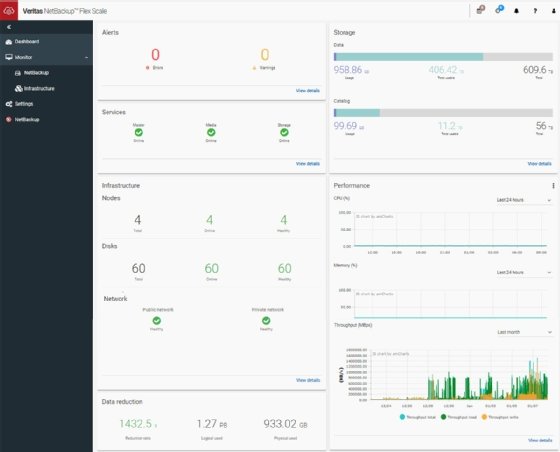
Konstantin Emelyanov - Fotolia
Veritas NetBackup 9 adds Flex Scale scale-out architecture
NetBackup 9 offers a new scale-out deployment aimed at software-defined, hyper-converged data centers, allowing customers to add storage nodes as they see fit.
Veritas restructured its backup software with NetBackup 9, adding a scale-out deployment option called Flex Scale.
NetBackup Flex Scale uses the same agents and base software, and supports the same workloads as the NetBackup data protection software Veritas has been selling for decades. However, instead of being locked into the storage capacity defined by the hardware NetBackup lives on, Flex Scale uses a scale-out, pay-as-you-go storage model that lets customers add storage nodes as needed. NetBackup Flex Scale appliances start at four nodes of 112 TB useable storage each, with a maximum limit of 16 nodes (i.e., 1.8 PB useable storage).
Traditionally, purpose-built backup appliances are sold with set capacities, and customers must buy the right size. This typically means having to predict their capacity needs in the next three years. Flex Scale enables administrators to buy less storage up front because they can scale as needed.
Veritas also still sells NetBackup through traditional, scale-up appliances with the software installed and as Kubernetes-based appliances (called NetBackup Flex, which is different from the new Flex Scale).
Doug Matthews, vice president of product management at Veritas, said NetBackup 9 was designed for the hyper-converged, multicloud world. He said many businesses use the cloud because it is simple to scale and consumption-based, so it made sense that NetBackup have the same capabilities. Nevertheless, there are still customers that prefer the traditional, scale-up purpose-built backup appliance route; Matthews said it was important that Veritas offer every deployment option to cover every customer need.
Christophe Bertrand, senior analyst at Enterprise Strategy Group (ESG), a division of TechTarget, described NetBackup 9 as a "heavy lift." From a development standpoint, it's no small task to turn backup software designed for set storage environments and sizes into something open and scalable. The conversion from scale-up to scale-out meant Veritas "basically containerized and re-platformed" all of NetBackup. Bertrand said this is a major, logical step along NetBackup's development.

"They've made their way from traditional scale-up appliances to decoupling the software from the hardware, to virtualizing, to containerizing and to now being software-defined. It's hyper-converged on steroids, since you can add nodes as you go," Bertrand said.
NetBackup 8 was released in December 2016, making NetBackup 9 the first major release for the platform in four years. However, NetBackup's incremental updates between releases have improved the platform. NetBackup 8.2 added Red Hat Virtualization support in June 2019, and 8.3 folded Veritas Resiliency Platform and CloudPoint into the platform in July 2020.
Aside from the scale-out architecture, NetBackup 9 also added automation features. Users can now set policies to automate tasks such as deployment, provisioning, load balancing and recovery. The software can now automatically discover all workloads in an environment, which an admin can then choose to protect with one click. NetBackup's APIs have expanded in this update to the point where, according to Matthews, the software can be fully controlled via API.
NetBackup 9 added integration with the OpenStack cloud computing platform, including support for the Horizon user interface. Matthews said some Veritas customers asked for this support, and, while there aren't a large number of them, they each have hundreds of petabytes of storage in OpenStack that need data protection.
ESG senior lab analyst Vinny Choinski said Veritas' claim of supporting 800 workloads isn't trivial, as one of NetBackup's differentiators is broad platform coverage. NetBackup has been around for decades, and addresses one of the biggest challenges of customers with a wide range of workloads by reducing the need for point data protection products for each one.
"If you can keep everything in a single management place, you're doing good," Choinski said.
Johnny Yu covers enterprise data protection news for TechTarget's Storage sites SearchDataBackup and SearchDisasterRecovery. Before joining TechTarget in June 2018, he wrote for USA Today's consumer product review site, Reviewed.com.







